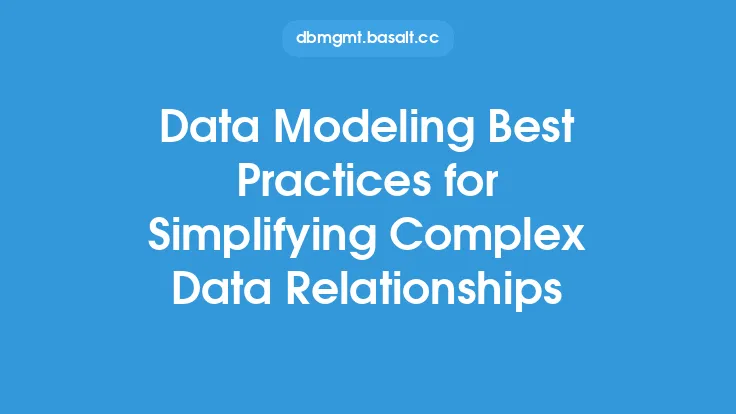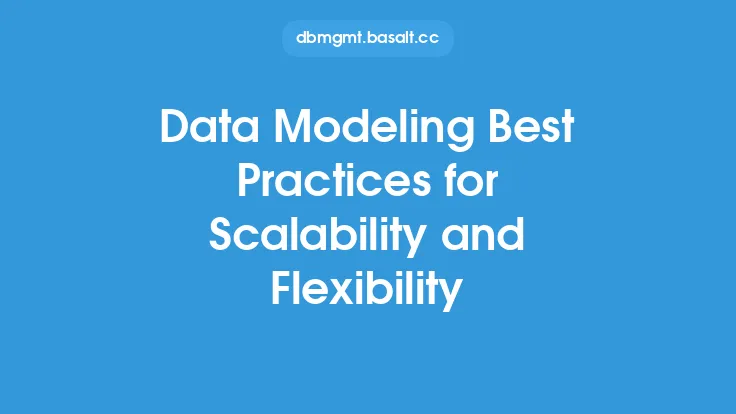Data modeling is a crucial aspect of data governance, as it enables organizations to create a conceptual representation of their data assets, ensuring that data is accurate, consistent, and accessible. Effective data modeling is essential for data governance, as it provides a framework for understanding the relationships between different data entities, identifying data quality issues, and ensuring that data is properly secured and managed. In this article, we will discuss the best practices for data modeling in the context of data governance, highlighting the key principles, techniques, and tools that organizations can use to create robust and scalable data models.
Introduction to Data Modeling for Data Governance
Data modeling for data governance involves creating a comprehensive and integrated view of an organization's data assets, including data entities, relationships, and rules. This requires a deep understanding of the organization's business processes, data sources, and data usage patterns. A well-designed data model provides a foundation for data governance, enabling organizations to identify data quality issues, ensure data consistency, and implement data security and access controls. Data modeling for data governance involves several key activities, including data discovery, data classification, data normalization, and data relationship mapping.
Data Discovery and Classification
Data discovery is the process of identifying and cataloging an organization's data assets, including data entities, attributes, and relationships. This involves analyzing data sources, such as databases, files, and applications, to identify the data that is being collected, stored, and used. Data classification is the process of assigning a classification level to each data entity, based on its sensitivity, criticality, and business value. This helps organizations to prioritize their data governance efforts, focusing on the most critical and sensitive data assets. Data classification also enables organizations to implement appropriate data security and access controls, ensuring that sensitive data is properly protected.
Data Normalization and Denormalization
Data normalization is the process of organizing data into a consistent and logical structure, eliminating data redundancy and improving data integrity. Normalization involves applying a set of rules to ensure that each data entity has a unique identifier, and that data relationships are properly defined. Denormalization, on the other hand, involves intentionally deviating from normalization rules to improve data performance or reduce data complexity. Denormalization can be useful in certain situations, such as improving query performance or reducing data joins. However, it can also lead to data inconsistencies and errors, if not properly managed.
Data Relationship Mapping
Data relationship mapping is the process of identifying and documenting the relationships between different data entities. This involves analyzing data sources and business processes to identify the relationships between data entities, such as customer orders and products. Data relationship mapping helps organizations to understand how data is used and shared across different business processes and systems, enabling them to identify data quality issues and implement data governance controls. Data relationship mapping also enables organizations to identify opportunities for data integration and consolidation, reducing data redundancy and improving data consistency.
Data Governance and Data Quality
Data governance and data quality are closely related, as data governance provides a framework for ensuring that data is accurate, complete, and consistent. Data quality issues, such as data errors, inconsistencies, and duplicates, can have a significant impact on business operations and decision-making. Effective data modeling is essential for identifying and addressing data quality issues, as it provides a comprehensive view of an organization's data assets and relationships. Data governance involves implementing policies, procedures, and controls to ensure that data is properly managed and maintained, including data validation, data cleansing, and data normalization.
Data Security and Access Control
Data security and access control are critical components of data governance, as they ensure that sensitive data is properly protected and accessed. Data modeling plays a key role in data security and access control, as it provides a framework for identifying and classifying sensitive data, and implementing appropriate access controls. Data modeling involves identifying the data entities and relationships that require special protection, such as customer personal data or financial information. Data security and access control involve implementing technical controls, such as encryption, access controls, and auditing, to ensure that sensitive data is properly protected.
Data Modeling Tools and Techniques
There are several data modeling tools and techniques that organizations can use to create robust and scalable data models. These include entity-relationship modeling, object-role modeling, and dimensional modeling. Entity-relationship modeling is a widely used technique that involves identifying and documenting the relationships between data entities. Object-role modeling is a more advanced technique that involves modeling data entities and relationships as objects and roles. Dimensional modeling is a technique that involves organizing data into a star or snowflake schema, to improve query performance and data analysis.
Best Practices for Data Modeling
There are several best practices that organizations can follow to create effective data models for data governance. These include:
- Developing a comprehensive data governance framework that includes data modeling, data quality, and data security
- Involving business stakeholders and data owners in the data modeling process to ensure that data models are accurate and relevant
- Using standardized data modeling techniques and tools to ensure consistency and scalability
- Implementing data validation and data cleansing rules to ensure data quality and consistency
- Providing training and support to data modelers and data analysts to ensure that they have the skills and knowledge needed to create and maintain effective data models
- Continuously monitoring and updating data models to ensure that they remain relevant and effective in supporting business operations and decision-making.
Conclusion
Data modeling is a critical component of data governance, as it provides a framework for understanding the relationships between different data entities, identifying data quality issues, and ensuring that data is properly secured and managed. Effective data modeling involves several key activities, including data discovery, data classification, data normalization, and data relationship mapping. By following best practices for data modeling, organizations can create robust and scalable data models that support business operations and decision-making, while ensuring that sensitive data is properly protected and accessed.





